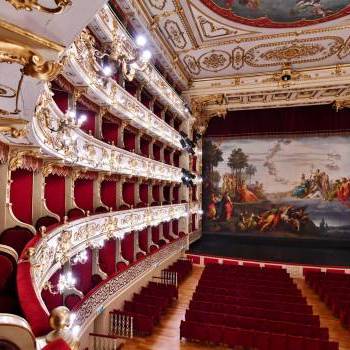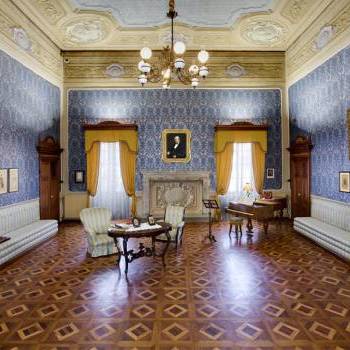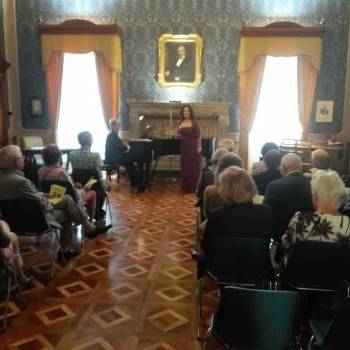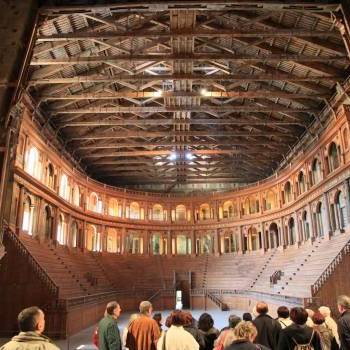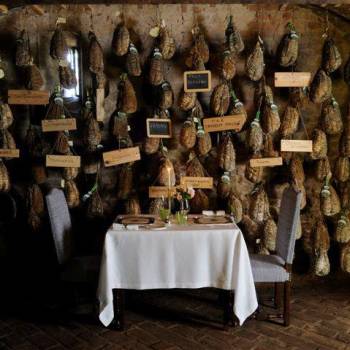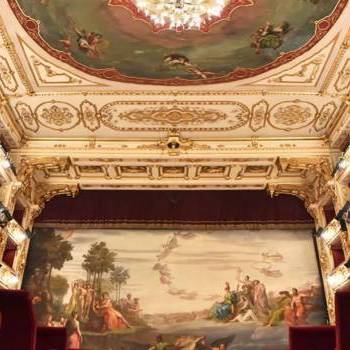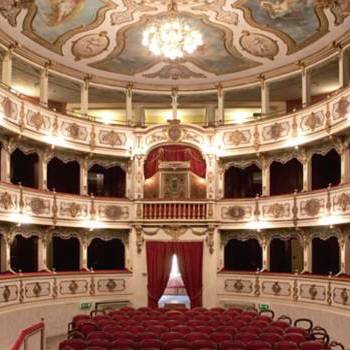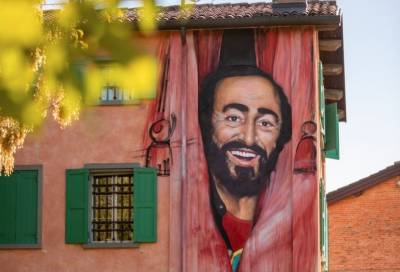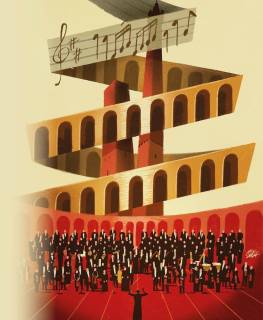
Parma, in the Footsteps of Verdi
A journey to the places of the great composer
4 days / 3 nights - Travel idea
Suggested time: in combination with the Opera programme at the Teatro Regio di Parma and the Verdi Festival
Gastronomy and Culture: this is what comes to mind when thinking of Parma and its lands; above all, the figure of Giuseppe Verdi stands out, who was born here and who, despite being a great traveler, always remained closely linked to these places. An itinerary in the footsteps of the Maestro, with some delights for the palate…
Block notes:
- Giuseppe Verdi - The places where he was born and that he frequented during his life.
- The Music - Organ concert at the Teatro Regio by the Organ Academy of Parma; private concert at Casa Barezzi in Busseto.
- Tasting - Tasting of culatello and local products.
Indicative itinerary proposal. The tour can be modified and adapted to any requests for further information on topics chosen by the customer.
Day 1 – Parma – Polesine Parmense
Independent arrival at the hotel in Parma.
Accommodation in the reserved rooms at Starhotels Du Parc 4* or similar category.
Afternoon: Departure by coach for Polesine Parmense to visit the Culatello and Masalén Museum.
Culatello and Masalén Museum
The complex of the Antica Corte Pallavicina of Polesine stands out in a glimpse of Bassa dominated by the sound of the Great River. The museum itinerary presents, one after the other, the protagonists of the Culatello story. The first is the territory: the environment, the poplar groves, the Po are the protagonists of a narration that leads to the room focused on the figure of the pig, domesticated by man in ancient times, with insights into the typical black pig of Parma and its recovery, the symbolism and the image of a creature so linked to man that it was chosen to evoke his vices and virtues.
Dinner with tasting including cured meats and Parmigiano Reggiano.
Return to Parma by coach.
Day 2 – Le Terre Verdiane: Roncole, Busseto, Sant’Agata
Breakfast at the hotel.
Morning: Departure by coach to the Verdi Places: Birthplace in Roncole and Villa Verdi in Sant’Agata where the composer lived for 50 years.
Roncole: the birthplace of Giuseppe VerdiGiuseppe Verdi was born for the first time on October 10, 1813. His childhood and adolescence were spent in this quiet hamlet of Busseto, on the outskirts of Parma, where he found inspiration in the natural beauty and local traditions. One of the main attractions is the “Birthplace of Giuseppe Verdi”, now a museum dedicated to the great composer. This modest house was where Verdi spent the early years of his life and where he had his first contact with music. The museum houses a collection of personal objects, original scores, letters and other memorabilia that shed light on Verdi’s life and career.
Villa Verdi in Sant’Agata
Immersed in the enchanting landscape of the Terre di Verdi, Villa Verdi is an architectural and cultural jewel that embodies the legacy and intimate bond between Giuseppe Verdi and the Emilian countryside. This country villa, located in Sant’Agata, near Busseto, represents a place of inspiration and creation for one of the greatest composers in the history of music, who lived here for more than fifty years with Giuseppina Strepponi. Villa Verdi was acquired by Giuseppe Verdi in 1848, becoming a beloved refuge and a place of retreat from the frenzy of city life. Here, within the walls of this elegant residence, some of the composer’s most famous works were born, such as “Rigoletto”, “Il trovatore” and “La forza del destino”.
Continue by coach to Busseto and lunch.
Visit the small Teatro Verdi and Casa Barezzi Museum with a PRIVATE CONCERT.
Return to Parma by coach. Free dinner.
Busseto: the city of Verdi
In the heart of the fascinating Lands of Verdi lies a cultural and musical jewel: the picturesque city of Busseto, where Giuseppe Verdi spent his youth.Here everything recalls the exploits of the famous composer, starting from the Teatro Verdi, a nineteenth-century theater located in the Rocca (formerly the Pallavicino Castle) inaugurated in 1868 in honor of the Maestro, who however never set foot there. The hall, splendidly preserved, offers a taste of the theatrical atmosphere of those times and constitutes an important piece of the musical history of Busseto.
Right in front of the theater is the Casa Barezzi Museum, where a young Verdi grew up in the presence of his mentor: Alberto Barezzi, a man who had intuited the enormous potential of the musician, contributing to his education and rise. The house hosts a museum itinerary of memorabilia related to the Maestro, who performed to the public for the first time in the historic Hall, today home to the Friends of Verdi Association.
Day 3 – Parma
Breakfast at the hotel.
Morning: Walking tour of the city of Parma and in particular the Teatro Regio where we will attend an organ performance by the Organ Academy of Parma. At the end, a hearty aperitif.
Teatro Regio di Parma
The neoclassical architecture, the harmony of its proportions, its history and tradition make the Teatro Regio di Parma one of the most prestigious opera houses in the world.
Commissioned by Duchess Maria Luigia of Habsburg-Lorraine, it was inaugurated on May 16, 1829 with the opera Zaira composed by Vincenzo Bellini. The perfect acoustics of the hall decorated by Girolamo Magnani, which shines with gold illuminated by the sparkling Astrolampo, intertwines with the celebrity of the artists who have graced its stage. Sophisticated and elegant, the Regio di Parma promotes and enhances its inestimable historical and cultural heritage through a rich calendar of operas, concerts, dance performances and events and every year organizes the Festival Verdi, the only monographic festival dedicated to the most performed composer in the world, awarded in 2017 as “Best Festival” at the International Opera Awards.
In the afternoon, visit the Farnese Crypts, inside the Basilica of Santa Maria della Steccata, a place inextricably linked to Verdi where the Maestro went when he was in search of inspiration..
Basilica of Santa Maria della Steccata
The Magistral Basilica of Santa Maria della Steccata is a Marian sanctuary built in Parma between 1521 and 1539 and elevated to the dignity of a minor basilica in 2008. The interior is decorated with frescoes from the Parma school of the 17th century. Also interesting are the cabinet-making works for the sacred furnishings of the noble sacristy, now part of the Constantinian Museum of the Steccata, and the stalls of the knights' choir. In 1823, at the behest of Maria Luigia of Austria, a crypt was built to preserve the tombs of the dukes and princes of the Farnese and Bourbon-Parma houses (the ashes were transferred from the church of Santa Maria del Tempio).
We will continue towards the imposing Palazzo della Pilotta, where the Teatro Farnese was built.
Free dinner.
Palazzo della Pilotta
The Palazzo della Pilotta is a monumental complex consisting of several buildings on which numerous architects worked at different times. Originally conceived as a container for the services of the Farnese court, designed to integrate the system of ducal residences, connecting the Palazzo di Rappresentanza (now Palazzo del Giardino), located beyond the stream and the more modest building that housed the headquarters of the Farnese court, located on the opposite bank near the historic center, now no longer existing, it was expanded between the sixteenth and seventeenth centuries until it assumed the imposing dimensions that still characterize its gigantic mass, almost out of proportion compared to the small size of the ancient city.
Teatro Farnese
The Teatro Farnese occupies an enormous hall used as a weapons room for the court's chivalric exercises, adapted and transformed into a hall for performances between the end of 1617 and the autumn of 1618. Built using unusual materials such as wood, straw and painted stucco, the theatre has rational characteristics of an oval-shaped structure, two orders of loggias, mobile scenes and balanced decorations. The construction was entrusted to Giovanni Battista Aleotti, an architect and military engineer, scholar and author of theatrical structures and machines. The inauguration of the theatre took place only in 1628, on the occasion of the wedding between Margherita de' Medici and Duke Odoardo Farnese. The theatre was used only eight other times, from 1652 to 1732, on the occasion of illustrious visits or ducal weddings. The Farnese was abandoned when Maria Luigia commissioned Nicolò Bettoli in 1829 to build the new Teatro Ducale.
Day 4 – Departure
Breakfast at the hotel and check-out of the rooms.
Independent departure.
The order of the visits may vary for operational needs without changing the content.
Recommended period: in combination with the Opera program at the Teatro Regio di Parma and the Verdi Festival
Day 1 – Parma – Polesine Parmense
Independent arrival at the hotel in Parma.
Accommodation in the reserved rooms at Starhotels Du Parc 4* or similar category.
Afternoon: Departure by coach for Polesine Parmense to visit the Culatello and Masalén Museum.
Culatello and Masalén Museum
The complex of the Antica Corte Pallavicina of Polesine stands out in a glimpse of Bassa dominated by the sound of the Great River. The museum itinerary presents, one after the other, the protagonists of the Culatello story. The first is the territory: the environment, the poplar groves, the Po are the protagonists of a narration that leads to the room focused on the figure of the pig, domesticated by man in ancient times, with insights into the typical black pig of Parma and its recovery, the symbolism and the image of a creature so linked to man that it was chosen to evoke his vices and virtues.
Dinner with tasting including cured meats and Parmigiano Reggiano.
Return to Parma by coach.
Day 2 – Le Terre Verdiane: Roncole, Busseto, Sant’Agata
Breakfast at the hotel.
Morning: Departure by coach to the Verdi Places: Birthplace in Roncole and Villa Verdi in Sant’Agata where the composer lived for 50 years.
Roncole: the birthplace of Giuseppe VerdiGiuseppe Verdi was born for the first time on October 10, 1813. His childhood and adolescence were spent in this quiet hamlet of Busseto, on the outskirts of Parma, where he found inspiration in the natural beauty and local traditions. One of the main attractions is the “Birthplace of Giuseppe Verdi”, now a museum dedicated to the great composer. This modest house was where Verdi spent the early years of his life and where he had his first contact with music. The museum houses a collection of personal objects, original scores, letters and other memorabilia that shed light on Verdi’s life and career.
Villa Verdi in Sant’Agata
Immersed in the enchanting landscape of the Terre di Verdi, Villa Verdi is an architectural and cultural jewel that embodies the legacy and intimate bond between Giuseppe Verdi and the Emilian countryside. This country villa, located in Sant’Agata, near Busseto, represents a place of inspiration and creation for one of the greatest composers in the history of music, who lived here for more than fifty years with Giuseppina Strepponi. Villa Verdi was acquired by Giuseppe Verdi in 1848, becoming a beloved refuge and a place of retreat from the frenzy of city life. Here, within the walls of this elegant residence, some of the composer’s most famous works were born, such as “Rigoletto”, “Il trovatore” and “La forza del destino”.
Continue by coach to Busseto and lunch.
Visit the small Teatro Verdi and Casa Barezzi Museum with a PRIVATE CONCERT.
Return to Parma by coach. Free dinner.
Busseto: the city of Verdi
In the heart of the fascinating Lands of Verdi lies a cultural and musical jewel: the picturesque city of Busseto, where Giuseppe Verdi spent his youth.Here everything recalls the exploits of the famous composer, starting from the Teatro Verdi, a nineteenth-century theater located in the Rocca (formerly the Pallavicino Castle) inaugurated in 1868 in honor of the Maestro, who however never set foot there. The hall, splendidly preserved, offers a taste of the theatrical atmosphere of those times and constitutes an important piece of the musical history of Busseto.
Right in front of the theater is the Casa Barezzi Museum, where a young Verdi grew up in the presence of his mentor: Alberto Barezzi, a man who had intuited the enormous potential of the musician, contributing to his education and rise. The house hosts a museum itinerary of memorabilia related to the Maestro, who performed to the public for the first time in the historic Hall, today home to the Friends of Verdi Association.
Day 3 – Parma
Breakfast at the hotel.
Morning: Walking tour of the city of Parma and in particular the Teatro Regio where we will attend an organ performance by the Organ Academy of Parma. At the end, a hearty aperitif.
Teatro Regio di Parma
The neoclassical architecture, the harmony of its proportions, its history and tradition make the Teatro Regio di Parma one of the most prestigious opera houses in the world.
Commissioned by Duchess Maria Luigia of Habsburg-Lorraine, it was inaugurated on May 16, 1829 with the opera Zaira composed by Vincenzo Bellini. The perfect acoustics of the hall decorated by Girolamo Magnani, which shines with gold illuminated by the sparkling Astrolampo, intertwines with the celebrity of the artists who have graced its stage. Sophisticated and elegant, the Regio di Parma promotes and enhances its inestimable historical and cultural heritage through a rich calendar of operas, concerts, dance performances and events and every year organizes the Festival Verdi, the only monographic festival dedicated to the most performed composer in the world, awarded in 2017 as “Best Festival” at the International Opera Awards.
In the afternoon, visit the Farnese Crypts, inside the Basilica of Santa Maria della Steccata, a place inextricably linked to Verdi where the Maestro went when he was in search of inspiration..
Basilica of Santa Maria della Steccata
The Magistral Basilica of Santa Maria della Steccata is a Marian sanctuary built in Parma between 1521 and 1539 and elevated to the dignity of a minor basilica in 2008. The interior is decorated with frescoes from the Parma school of the 17th century. Also interesting are the cabinet-making works for the sacred furnishings of the noble sacristy, now part of the Constantinian Museum of the Steccata, and the stalls of the knights' choir. In 1823, at the behest of Maria Luigia of Austria, a crypt was built to preserve the tombs of the dukes and princes of the Farnese and Bourbon-Parma houses (the ashes were transferred from the church of Santa Maria del Tempio).
We will continue towards the imposing Palazzo della Pilotta, where the Teatro Farnese was built.
Free dinner.
Palazzo della Pilotta
The Palazzo della Pilotta is a monumental complex consisting of several buildings on which numerous architects worked at different times. Originally conceived as a container for the services of the Farnese court, designed to integrate the system of ducal residences, connecting the Palazzo di Rappresentanza (now Palazzo del Giardino), located beyond the stream and the more modest building that housed the headquarters of the Farnese court, located on the opposite bank near the historic center, now no longer existing, it was expanded between the sixteenth and seventeenth centuries until it assumed the imposing dimensions that still characterize its gigantic mass, almost out of proportion compared to the small size of the ancient city.
Teatro Farnese
The Teatro Farnese occupies an enormous hall used as a weapons room for the court's chivalric exercises, adapted and transformed into a hall for performances between the end of 1617 and the autumn of 1618. Built using unusual materials such as wood, straw and painted stucco, the theatre has rational characteristics of an oval-shaped structure, two orders of loggias, mobile scenes and balanced decorations. The construction was entrusted to Giovanni Battista Aleotti, an architect and military engineer, scholar and author of theatrical structures and machines. The inauguration of the theatre took place only in 1628, on the occasion of the wedding between Margherita de' Medici and Duke Odoardo Farnese. The theatre was used only eight other times, from 1652 to 1732, on the occasion of illustrious visits or ducal weddings. The Farnese was abandoned when Maria Luigia commissioned Nicolò Bettoli in 1829 to build the new Teatro Ducale.
Day 4 – Departure
Breakfast at the hotel and check-out of the rooms.
Independent departure.
The order of the visits may vary for operational needs without changing the content.
Recommended period: in combination with the Opera program at the Teatro Regio di Parma and the Verdi Festival

